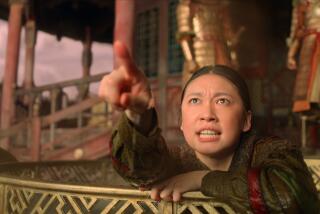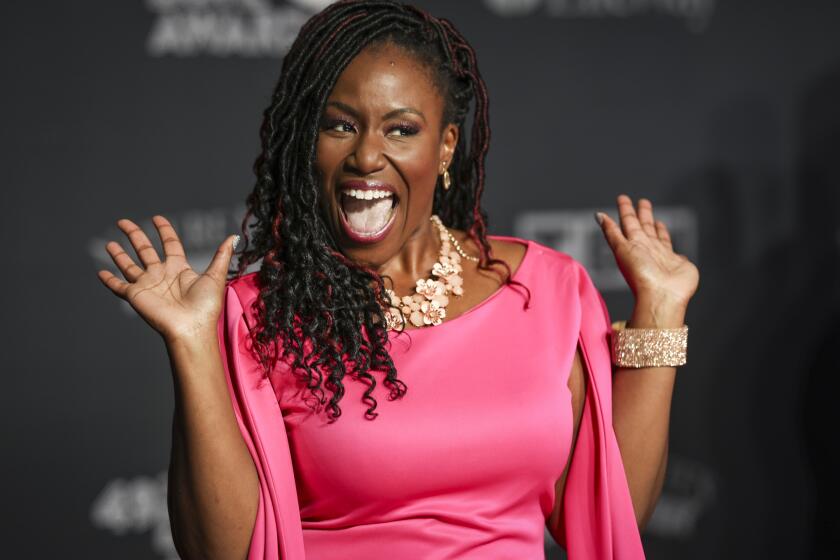It’s not TV... but what is it? As Netflix continues to expand, its identity has gotten fuzzy
Ok, class. Time for a pop quiz. Which of the following is not an actual show released by Netflix in the last six months?
a) “3%,” a dystopian thriller from Brazil
b) “Quinnsurrection,” a loosely autobiographical dramedy starring Colin Quinn as a mistanthropic comedian
c) “Beat Bugs,” a kids’ show about backyard insects, featuring music by the Beatles
d) “Haters Back Off,” a comedy about a wannabe YouTube star
If you said (b), you’re right. But let’s face it: Unless you happen to write about television for a living (and even if you do) you may have had to give it some thought.
Since its first commissioned series “House of Cards” was released in February 2013, the streaming service has expanded its original (and acquired) programming at a dizzying rate. What began as a steady flow — the “Arrested Development” reboot a few months later, followed by the premiere of “Orange Is the New Black” — has turned into a full-blown torrent.
In the last month alone, Netflix has released a revival of a beloved, female-skewing CW dramedy (“Gilmore Girls: A Year in the Life”); a trippy supernatural mystery from two acclaimed indie filmmakers (“The OA”); and a miniseries about the life of Pope Francis (“Call Me Francis”). That’s not even getting into Netflix’s growing stable of feature films, such as the recent biopic “Barry,” about a young Barack Obama.
And the tsunami will grow only larger in the coming year, during which Netflix plans to roll out 1,000 hours of original programming — enough to sustain nearly 42 days of binge-watching.. That’s a whole lot of TV, even in a country of couch potatoes.
Forget about Peak TV; we’ve reached Peak Netflix.
Forget about Peak TV; we’ve reached Peak Netflix.
But as Netflix’s profile has grown, its once-sharp identity has grown more diffuse. In 2013, the goal was to “become HBO faster than HBO can become us,” according to Chief Content Officer Ted Sarandos, by programming a mix of ambitious, character-driven dramas, offbeat comedies, socially relevant documentaries and comedy specials.
But the network quickly added a spate of Marvel comic book shows, idiosyncratic comedies that would be at home on FX and enough children’s programs to fill a standalone cable channel.
Any attempt to define Netflix’s brand these days seems to be an exercise in frustration. How do you possibly characterize a service that offers both a critically reviled revival of a bad ’80s-spawned sitcom (“Fuller House”) and the continuation of a niche favorite British series exploring the darker side of technology (“Black Mirror”), except to say it’s pretty inclusive?
If the proliferation of original series on cable networks and streaming platforms over the last decade has drawn viewers away from traditional broadcasters which, a generation ago, once held something close to a monopoly, Netflix is trying to reverse this trend, to become a one-stop shop for every conceivable form of visual entertainment.
As Sarandos told reporters at the Television Critics Assn. press tour in 2013, “We’re not just competing with ‘Fresh Off the Boat,’ we’re competing with ‘Pokemon Go’ and ‘Star Wars’ movies and ‘Jurassic World.’ We’re competing for a lot of attention in a really noisy world.”
Quotes like that make me feel (however fleetingly) for development executives at Netflix, whose apparent mission is to create shows and movies — excuse me, content — that might theoretically appeal to 86 million global subscribers and counting, whether they’re looking for an engrossing drama or something inoffensive to half-watch while folding the laundry.
On one level, this expansive approach is commendable, particularly in an era when pop culture, like politics, has become deeply factionalized, and the gap between the shows entertainment journalists obsess over and what vast numbers of Americans actually watch has only grown wider. (“Game of Thrones” is arguably the only current show that captures both demographics.)
But being everything to everyone is not only exhausting, it’s also an ineffective strategy for building new hits. Having a recognizable brand identity isn’t just about marketing, it’s about creative focus and financial priorities. Writers, producers and talent are drawn to Netflix for the creative freedom it famously affords, but if the service has more shows than it can realistically promote, if it’s just adding to the pop-culture clutter, will it remain as enticing an option?
And its attempts to expand into new genres haven’t always been successful. “Chelsea,” the thrice-weekly talk show hosted by Chelsea Handler, got a lot of initial attention but has barely made an impression since, possibly because the watch-when-you-want streaming model seems an odd fit for a topical format. “Marco Polo,” a sweeping and expensive historical epic with “Game of Thrones” aspirations, was canceled this month after two buzz-free seasons.
Though it’s quickly proved to be an awards contender, just last week landing two drama series nominations at the Golden Globes (for “Stranger Things” and “The Crown”), Netflix certainly can’t be accused of elitism. Seemingly every day, the trades run headlines about Netflix winning a bidding war for the latest coveted project in town, so why is it bothering with something like “Real Rob,” starring the not-exactly-hot Rob Schneider?
“The Crown” might ooze prestige, but the same can’t be said of “The Ranch,” a serviceable multi-camera, laugh-track sitcom that seems like something that could have aired on CBS a decade ago — and not necessarily in a bad way — but hasn’t broken out in any quantifiable manner.
With a cast of familiar, well-liked performers, including Ashton Kutcher and Sam Elliott, “The Ranch” might be the kind of show Netflix could point to as a popular, big-tent sitcom, a la “The Big Bang Theory,” that may not win awards or gushing praise but helps keep the lights on.
But the network continues to keep ratings information a closely held secret. It could be that the media should be paying more attention to “The Ranch,” but without strong word of mouth or hard evidence of a large audience, we have no reason to do so.
There’s no question that Netflix has created major buzz with its originals, but the shows that cut through the noise are often more under-the-radar projects that exceed expectations. “Stranger Things” was released to little fanfare and received roughly a tenth of the promotional push behind “Gilmore Girls: A Year in the Life” or “The Get Down,” Baz Luhrmann’s costly hip-hop drama, but arguably became the show of the year, thanks largely to its ragtag ensemble of unknown but talented child actors.
In its defining years, HBO had “it’s not TV, it’s HBO.” AMC had “story matters here.” Tellingly, Netflix doesn’t even have a slogan.
The expression “Netflix and chill” hints at its formlessness: It’s the thing teenagers put on in the background while making out.
But it also speaks to the Netflix’s cultural pervasiveness. Netflix no longer has a distinct programming brand, but in a few short years it has become the default place for many to watch TV. And in a landscape where the choices can be downright overwhelming, that’s a powerful advantage — at least for now.
Staff writer Yvonne Villarreal contributed to this report.
See the most-read stories in Entertainment this hour »
Follow me @MeredithBlake
ALSO
Riz Ahmed and ‘The Night Of’ strike a chord of contemporary concerns
2016 in review: The entertainment industry moves on to what’s next
More to Read
The complete guide to home viewing
Get Screen Gab for everything about the TV shows and streaming movies everyone’s talking about.
You may occasionally receive promotional content from the Los Angeles Times.






